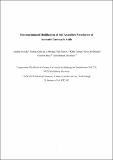Files in this item
Electron-induced modification of self-assembled monolayers of aromatic carboxylic acids
Item metadata
| dc.contributor.author | Asyuda, Andika | |
| dc.contributor.author | de la Morena, Rodrigo Ortiz | |
| dc.contributor.author | Sauter, Eric | |
| dc.contributor.author | Turner, Kelly | |
| dc.contributor.author | McDonald, Kirsty | |
| dc.contributor.author | Buck, Manfred | |
| dc.contributor.author | Zharnikov, Michael | |
| dc.date.accessioned | 2021-10-29T23:38:50Z | |
| dc.date.available | 2021-10-29T23:38:50Z | |
| dc.date.issued | 2020-11-12 | |
| dc.identifier | 271330914 | |
| dc.identifier | 289960d1-1e4d-499f-8298-55563823827f | |
| dc.identifier | 85095805678 | |
| dc.identifier | 000598992900055 | |
| dc.identifier.citation | Asyuda , A , de la Morena , R O , Sauter , E , Turner , K , McDonald , K , Buck , M & Zharnikov , M 2020 , ' Electron-induced modification of self-assembled monolayers of aromatic carboxylic acids ' , Journal of Physical Chemistry C , vol. 124 , no. 45 , pp. 25107-25120 . https://doi.org/10.1021/acs.jpcc.0c07577 | en |
| dc.identifier.issn | 1932-7447 | |
| dc.identifier.other | RIS: urn:DABDE08858CD2F5A96AFC783A88E8544 | |
| dc.identifier.other | ORCID: /0000-0003-1225-7607/work/83889270 | |
| dc.identifier.uri | https://hdl.handle.net/10023/24226 | |
| dc.description | A.A. acknowledges the financial support by the DAAD-Aceh Scholarship of Excellence. Financial support by EPSRC via doctoral training grants (R.O.d.l.M.) and the EPSRC Center for Doctoral Training in Critical Resource Catalysis (CRITICAT) (PhD studentship to K.T.) is gratefully acknowledged. | en |
| dc.description.abstract | The effects of low-energy electrons on aromatic self-assembled monolayers (SAMs) with carboxylic acid (CA) docking groups were studied with a focus on the dose range below 5 mC/cm2. The SAMs were prepared on an underpotentially deposited Ag bilayer and comprised nonsubstituted and CA-substituted monolayers with a rod-like biphenyl backbone and a monolayer of a Y-shaped, CA-substituted molecule, 1,3,5-benzenetribenzoic acid (H3BTB), formed either as a single-component film or as a binary one by mixing with adamantane-CA (Ad-CA). X-ray photoelectron and near-edge X-ray absorption fine structure spectra suggest high proneness of the CA groups to electron irradiation at both SAM/substrate and SAM/ambient interfaces. Cleavage of the carboxylate-substrate bond results in substantial molecular desorption at the initial stage of irradiation until electron-induced cross-linking gradually takes over. The CA groups at the outer SAM interface undergo substantial chemical changes, indicating that they participate in the cross-linking chemistry. The electron-induced processes are accompanied by molecular reorientation. Disordering for the SAMs formed by the rod-like molecules is contrasted by the H3BTB-based systems where changes also occur but some molecular order is preserved as explained by a proposed model invoking conformational changes. In SAMs of H3BTB mixed with Ad-CA, the latter shows higher proneness to irradiation-induced desorption than the former, as well as an influence on the cross-linking chemistry. The results of the present study suggest that CA-based SAMs on Ag offer additional options for cross-linking in SAMs and, as exemplarily demonstrated by the generation of Cu patterns on structured H3BTB templates, can be efficiently used for lithography and nanofabrication. | |
| dc.format.extent | 14 | |
| dc.format.extent | 1353601 | |
| dc.language.iso | eng | |
| dc.relation.ispartof | Journal of Physical Chemistry C | en |
| dc.subject | QD Chemistry | en |
| dc.subject | NDAS | en |
| dc.subject.lcc | QD | en |
| dc.title | Electron-induced modification of self-assembled monolayers of aromatic carboxylic acids | en |
| dc.type | Journal article | en |
| dc.contributor.sponsor | EPSRC | en |
| dc.contributor.institution | University of St Andrews. School of Chemistry | en |
| dc.contributor.institution | University of St Andrews. EaSTCHEM | en |
| dc.identifier.doi | https://doi.org/10.1021/acs.jpcc.0c07577 | |
| dc.description.status | Peer reviewed | en |
| dc.date.embargoedUntil | 2021-10-30 | |
| dc.identifier.grantnumber | EP/L016419/1 | en |
This item appears in the following Collection(s)
Items in the St Andrews Research Repository are protected by copyright, with all rights reserved, unless otherwise indicated.

